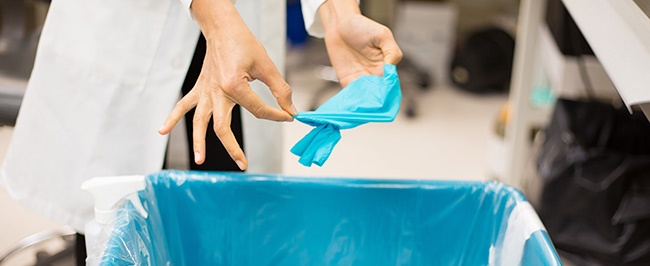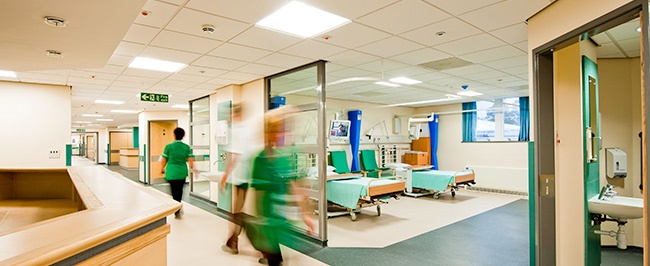A PRACTICAL GUIDE TO INFECTION CONTROL FOR HEALTHCARE FACILITIES
INTRODUCTION

According to the Centers for Disease Control (CDC), on any given day in the U.S., one in 25 hospital patients has at least one hospital-acquired infection (HAI).
All healthcare facilities take this issue seriously and, as a result, infections have decreased markedly since 2006. With the implementation of effective infection control policies, and the advancement of disease prevention solutions, there has been a 25% to 50% decrease in some of the most common types of HAIs:
- Central line-associated bloodstream infections
- Catheter-associated urinary tract infections
- Surgical site infections (CDC).
Still, with 75,000 patients in the United States having died from HAIs as recently as 2015, there is more infection control work in hospitals to be done. (CDC)
The easiest HAIs to prevent are pneumonia and gastrointestinal illness, more than half of which occur outside of the highly-protected intensive care unit. In addition to the extreme emotional and physical costs HAIs have on patients and their families, there is a significant economic cost associated with HAIs as well.
According to the World Health Organization (WHO), annual financial losses due to healthcare-associated infections are estimated at approximately €7 billion in Europe (including direct costs only and reflecting 16 million extra days of hospital stay) and at about US$ 6.5 billion in the United States. (WHO)
Infection control and disease prevention are necessary for the sake of patients as well as facilities, and it is critical that all healthcare facility staff are well-versed in the importance of infection control and the protocol required to keep patients safe.
While the CDC, WHO, and other healthcare organizations put out thorough infection control guidelines and infection control training, it is important that you have an understanding of the basic tenets of this critical part of patient care and how it relates to facilities management. Following, you will find an overview of the most important infection control principles for healthcare facilities as well as links to more extensive reading on each issue.
WHAT IS INFECTION CONTROL?

According to the CDC, infection control “prevents or stops the spread of infections in healthcare settings.” A healthcare provider’s infection control practices can range from the way in which patient rooms are cleaned to the frequency of hand washing by personnel.
It should come as no surprise that proper infection control is the most effective way to stem the spread and impact of hospital-acquired infections, no matter what the sources of infection may be.
An infection control protocol is essential for any healthcare facility, including acute care settings, ambulatory clinics, and long-term care facilities. While each facility may have particular practices that they enact in different ways and may have different approaches in how they communicate their methodologies, the basics of good infection control remain the same. Following are the most critical steps for proper infection control, according to the CDC.
ENVIRONMENTAL INFECTION CONTROL GUIDELINES

While patient care is, of course, critical in maintaining proper infection control protocol in a healthcare facility, environmental infection control is just as important. The environment that houses patients is, in most cases, the same place where those patients receive care from workers and
In addition, when one patient is discharged from a facility or moved to another room, that same environment then houses another patient, often in the same day. It is essential that all parts of the healthcare environment, from the patient care rooms to the waiting area, be maintained at a certain level of cleanliness in order to optimize infection control. It is environmental infection control where facilities managers and their staff can play the largest role.
Further reading: CDC Guidelines for Environmental Infection Control in Healthcare Facilities
Infection Control & Air
Airborne pathogens can be some of the most difficult to protect against in the healthcare environment. Not only can pathogens be transmitted from patients and HCWs, but they can also come into the facility through open windows, doors, and regular circulation.
HVAC
The heating, ventilation
Patient Isolation
Patients who meet certain criteria must be placed in rooms that are designed for maximum isolation. To ensure
Maintenance & Construction
While the pathogens that are transmitted by human beings can often be the focus of infection control protocol, maintenance and construction procedures can represent a significant risk to patients as well as healthcare workers. When work is done in any part of a healthcare facility that may disrupt dust and pathogens, including above-ceiling maintenance, it is critical that facilities utilize effective dust control procedures. In many cases, portable dust containment units may be the most practical solution for this.
Infection Control & Water
As noted above, hand hygiene is perhaps
Further, regular tests should be performed to ensure that the water coming into the facility is clean and free from harmful pathogens. Standing water can present a hazard, including infrequently used water tanks, so care must be shown to regularly maintain and disinfect all water supplies.
Cleaning & Disinfection
Patient Care Equipment
[See: Patient Care Infection Control Guidelines]
Patient Care Environment
The patient care environment consists of noncritical items -- meaning environmental items that only come into contact with intact skin, a natural barrier to infectious microorganisms. Examples of noncritical environmental items include walls and floors, bedpans, computers, crutches, and blood pressure cuffs.
Noncritical environmental items should be cleaned at regular intervals with low-level disinfectants. Of note is the fact that mops and mop water, when not laundered and changed regularly, can contribute to the spread of diseases, even though they themselves are noncritical, so it is important to put in place protocols that prevent this type of lapse.
What are some of the dirtiest places in a hospital? Check out our blog for 5 top offenders.
Textile Handling
All textiles in a healthcare facility must be regularly and properly laundered for infection control and general hygienic purposes. Personal protective equipment worn by healthcare workers or facility visitors must be regularly laundered at the facility, as well as curtains, bedding, and other soft surfaces that could harbor pathogens. A laundry facility that is equipped with handwashing capabilities and has been built in accordance with AIA construction standards is essential.
INFECTION CONTROL IN HOSPITALS

The above guidelines for infection control in healthcare facilities are barely the tip of the iceberg. Organizations such as the CDC, WHO, and AIA are able to offer much more thorough procedures for a comprehensive infection control program.
Utilizing infection control methods that are tested and proven is essential to the effectiveness of any hospital. Keep patients safe is, of course, the top priority, but in addition, HAIs can represent a significant cost to healthcare facilities. In fact, according to one study, HAIs can cost U.S. hospitals up to $45 billion per year.
This same analysis found that effective infection control could prevent up to $31 billion of these costs. Further, research shows that when healthcare facilities and their staff are aware of infection problems and take specific steps to prevent them, rates of some HAIs can decrease by more than 70 percent.
The ethical need for infection control is clear. Coupled with the actual costs to healthcare facilities and companies, the importance of infection control cannot be overstated.
BUILDING AN INFECTION CONTROL TEAM
Ultimately, it is the job of every healthcare facility employee to learn and practice good infection control policies. However, establishing an infection control team that acts as the ambassadors for policies, protocol and any changes that need to occur can be extremely effective.
An infection control team should consist of at least one clinical champion and one person from the facilities team who knows the intricacies of the facility cleaning and maintenance processes. Others may be added to the team for special projects as well, particularly major construction and renovation projects.
Members of the infection control team should be well-versed in infection control and open to or actively pursuing advanced training in infection control best practices.
Tasks for an Infection Control Team
The team that takes responsibility for your facility’s infection control policies should be the ones that:
- Regularly review and update the facility infection control policies
- Meet regularly to discuss the current state of infection control
- Track and report on incidents
- Recommend new infection control technology or policy
- Stay up-to-date on the latest infection control research and recommendations
- Initiate regular infection control awareness campaigns within the facility
- Communicate clearly with facility administration on all infection control issues
CONCLUSIONS

There is no question that infection control is a critical element to the sustained success of any healthcare facility. It is only when the patients are the priority and their safety is the top concern that hospitals and other healthcare facilities are able to grow and thrive.
Unfortunately, there are no quick fixes when it comes to infection control. Rather, diligence and ongoing education are the keys to ensuring patients safety and minimizing the possibility of hospital-acquired infections. Although advanced infection control technologies are making it easier to operate cleanly and safely, there is no substitute for attention to detail and a strong foundation knowledge of infection control principles.
Further Reading: Infection Control on the HEPACART Blog
Breathing in clean air in your medical facility or school shouldn’t be a luxury — it’s a necessity, especially during cold and flu season. That’s where efficient air filtration and purification comes...Read more
Modern healthcare facilities are an incredibly valuable resource for our communities, and their ability to provide a safe and healthy environment is critical to patients who walk through the doors....Read more
Ensuring the safety of both patients and healthcare staff from airborne pathogens is a challenge that no medical facility takes lightly. It’s why medical centers exist — to help patients become and...Read more
